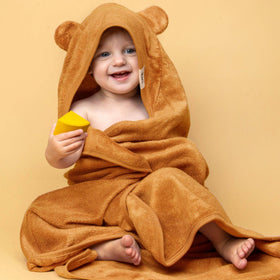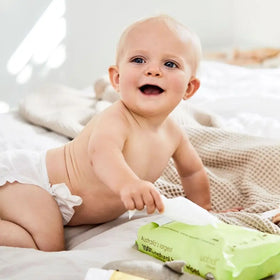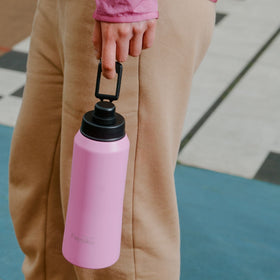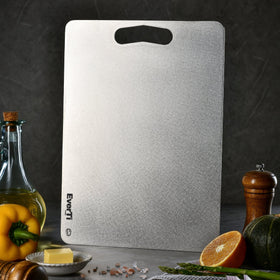
Why it's So Important to Go Non Toxic for Babies and Kids
Have you been thinking about choosing non toxic for your baby? Wondering if it's really worth putting in the effort to find non toxic products for your little one when surely the stuff at the supermarket is fine? Let me tell you, it certainly is worth making the effort. Children’s developing bodies and brains are more sensitive to the effects of chemicals than those of adults. Also, children breathe, eat, and drink more for their size than adults, which means that chemical levels can be higher in children than in adults doing the same things.
Children are also close to the ground and put their hands, toys, and lots of other things in their mouths. By reducing toxic chemicals in children's products and around the house, you can reduce the amount of chemicals they take in.

What happens when children are exposed to toxic chemicals?
Many common household chemicals are endocrine disruptors. They may harm your child’s developing hormonal and reproductive system, causing permanent damage that's sometimes even passed on to the next generation. We can't completely protect our babies from toxic stuff. These chemicals build up in the body over time. So it’s important to do all we can to limit exposure as much as possible.
How much of this stuff is out there, really?
A 2013 analysis found 66 'chemicals of high concern' in common children’s toys. For instance, cobalt, a toxic heavy metal that causes lung cancer and may affect reproductive health, was found in 1,228 individual products in 40 different categories. Cobalt makes a beautiful blue pigment that companies like Lego, Mattel, and the Gap use to colour their toys and baby clothes. We don’t know enough yet about the health risks of some of these chemicals to ban the use of them. Does cobalt in toys and clothes leach out and get into a kid’s bloodstream? How dangerous are low concentrations of methyl ethyl ketone? Nobody knows for sure, although it was reported in 400 products. (We know repeated exposure to high concentrations can damage the brain and nervous system.)
These days it's easy to find non toxic baby and kids products. We don’t know the long term consequences of some of the chemicals being used in the products children are exposed to. I want my children to grow up strong and healthy, and that means using natural children’s products all the way!
Non toxic baby toys
You should start planning on going non toxic for your baby as early as possible, preferably as soon as you start trying to get pregnant. (A 2009 study by the Environmental Working Group found traces of 232 synthetic chemicals in the umbilical cord blood of ten American babies.) Once the baby comes home with you, they need a completely non toxic environment as much as possible. The blood brain barrier is still developing, so the baby’s little brain is especially vulnerable.
First of all, do your research. Read labels, and ask questions. Be on the lookout for substances like:
- Bisphenol-A (BPA)
- Polyvinyl chloride (PVC or vinyl)
- Phthalates
- Cadmium
- Nickel
- Formaldehyde based glues
- Chlorine bleaches
- Flame retardants
It might be easier just to look for what's there:
- Toys made from solid wood and non toxic finishes, like beeswax and vegetable dyes
- Soft toys made from organic fibres, such as cotton, wool, bamboo, and corn
Good quality, organic baby toys may cost more, but they last longer so your child will get more enjoyment out of them. And you can pass them on to brothers, sisters, cousins, and friends. Most importantly, you’ll know that your baby is safe.
To get started, you can take a look at Hello Charlie’s shopping guide and selection of non toxic kids toys.
Safe baby food
A 2017 study by the Environmental Defense Fund found that there were actually more detectable lead levels in baby food samples (20%) than in regular food (14%). Some types of baby food had lead in over 40% of the samples! Any amount of lead is too much, especially when it comes to babies. The worst offenders were:- Sweet potato baby food
- Grape juice
- Mixed fruit juice
- Arrowroot biscuits
- Apple juice
- Teething biscuits
- Pear juice
- Carrot baby food
In general, it’s best to make your own baby food. (Check out our article on baby led weaning for some helpful tips on what to feed baby.) If you do use commercial food, like we all sometimes do when we’re pressed for time, look for a high quality organic baby food. When you’re feeding baby, it’s best to do it from non toxic kids dishes and utensils, made of safe plastic, stainless steel, or bamboo. Melamine dinnerware is popular because it's hard to break, but may cause kidney stones or other problems.
Non toxic baby bedding and nursery furniture
Your children spend at least ten hours a day sleeping, so you want to make their rooms as safe as possible. There are great companies here in Australia that specialise in non toxic bedding and mattresses for children. You can find organic clothes and hardwood furniture, too. When you’re looking for soft floor mats, make sure that they're formamide free. Or go with an organic cotton version, like these ones from Wee Gallery.
When you’re decorating baby’s room, always make sure to use non toxic paint. Ordinary paints can contain toxins such as xylene, toluene and formaldehyde, which cause indoor air pollution – bad for you and baby. Even if you use natural paint, it’s a good idea to open the windows for at least 15 minutes every day to air out the house and prevent chemicals from building up in the air.
Natural skincare and hair products for children
The skin is the body’s largest organ. When you’re giving bub a bath, the warm water opens up the pores and allows ingredients in the baby soap or baby body wash to penetrate the skin more easily. Another thing you need to watch out for is bubble bath, which can be just as problematic. Hello Charlie carries a wide variety of safe, non toxic baby washes, so you don’t have to worry while you wash. Our Safer Baby Bubble Bath Cheat Sheet will give you the lowdown on the most common baby bubble baths you can find in Australia.
Non toxic baby nappy care
A whiff of baby powder brings back nostalgic memories for most of us, but talcum powder is actually extremely harmful. It causes lung problems when inhaled and has been implicated in reproductive cancers, especially in girls. Look for a natural baby powder instead.
Nappy creams can be another cause for concern, since the skin is usually already broken when you apply them. I researched 44 natural nappy creams, and my results are available in the Best Nappy Rash Cream Cheat Sheet for you to download for free.
Sunscreens
Australian summers (and even winters) are bright and sunny. You and your baby need to protect your skin with sunscreens. I recommend a natural zinc based sunscreen – it’s better for you, your baby, and the environment.
Want to know more about what chemicals you should look out for when buying products for your baby? Check out our toxic living series here at Hello Charlie.










